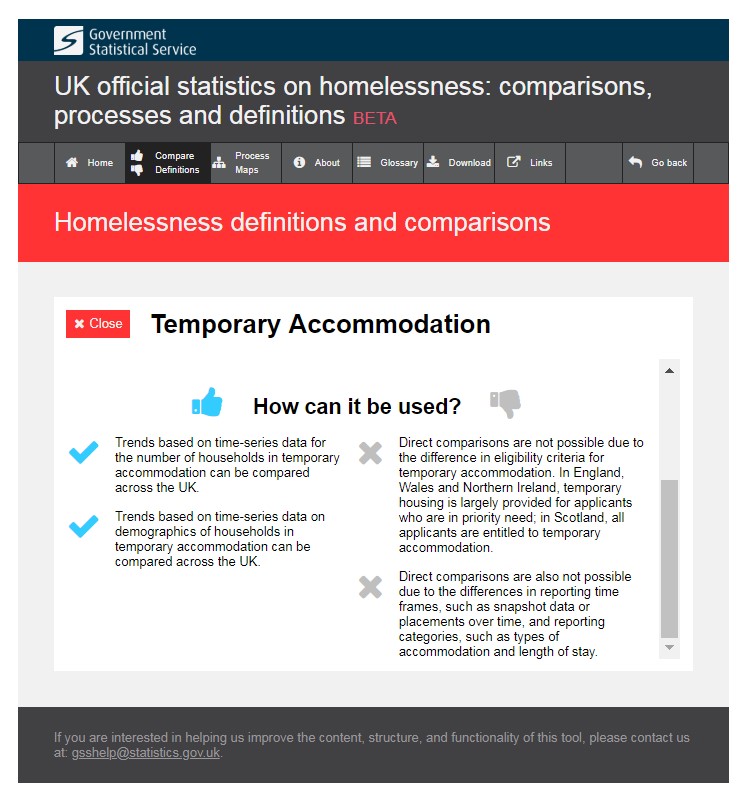The emerging picture of UK homelessness and rough sleeping

Today we’ve published an important update on the cross government project to improve the coherence of statistics produced on homelessness across the UK and build a better understanding of this critical social problem. The new work suggests that while the number of people seeking help for homelessness has remained broadly stable since 2013, there is some evidence the age profile of that group has become older. Here Debra Prestwood outlines the latest work to ensure statistics can answer important questions about homelessness and rough sleeping in the UK.
In order to deliver services and support to some of the most vulnerable people in our society, high-quality evidence and statistics on homelessness and rough sleeping are needed. The Office for National Statistics (ONS) last year produced the first ever data showing the number of people in England and Wales who have died homeless and this publication will be updated on 1st October to add figures for 2018.
However, the overall picture of how many people in the UK are affected by homelessness is hard to calculate. That’s why the Government Statistical Service (GSS) is working across departments and the devolved UK governments to better understand homelessness and some of the most vulnerable people in society.
We have published two new articles and a new interactive tool that together help build a more useful, comprehensive view of homelessness and rough sleeping across the UK. We have focused on the similarities and differences in our data and statistics, and this is the culmination of work from analysts from each of the four countries of the UK.
The GSS is focused on ensuring decision-makers across society have the right insight and evidence they need. We are striving to improve the UK-wide scope and coherence of these statistics, while acknowledging that laws, policies and data collection methods are different across the four countries of the UK.
Today’s publications
Our new analysis brings together homelessness statistics from across England, Wales, Scotland and Northern Ireland for the first time, building a comprehensive picture of the data available and how they compare.
It looks at trends in people seeking help for homelessness, use of temporary accommodation, demographics of homeless people, support needs and reasons people become homeless. It suggests that when applicants are found accommodation, Scotland and Northern Ireland rehome almost all applicants in social housing while England and Wales rehome across the social and private rented sector. And that there has been an increase in the complexity of homeless household needs in recent years, particularly in relation to physical and mental health conditions.
We have also published a broader article that shows how analysts across the UK are working together to so that policy and decision makers have the statistics and evidence to support people when they need it the most.
Alongside these two pieces of work, the GSS has produced a new interactive tool that shows the process a person may go through when seeking support for housing in each UK country, compares how each country’s statistics are collected and gives guidance on making comparisons. GSS’s harmonisation team plan to update this tool based on your feedback to improve the content and functionality. It builds on previous GSS research looking at the feasibility of harmonising definitions of homelessness. Why not explore the interactive tool here?

Understanding early indicators of homelessness
It is also important that we understand the complex drivers of homelessness and to do this the ONS has been working with the Centre for Homelessness Impact (CHI) to look deeper into the causes of homelessness across the UK. In the summer, over 500 users across the UK who have experience of working in and around homelessness have provided valuable insights into what the key indicators relating to ending homelessness should be. The results of this work are expected to be published soon and discussions are being held about how this can be taken forward.
Ensuring homeless people are included in the Census 2021 (England & Wales)
The ONS is also working with organisations that support and represent people who are homeless so that as many people as possible can make sure they count in the next census in March 2021.
All people who are homeless will be able to complete the census. For some this will be through a form at an address where they are temporarily staying, for example, with a friend or in a hostel. Others will be able to use the address of an establishment that they are in contact with (e.g. a day/night shelter).
Early in 2020, the ONS will host a session to rehearse the enumeration of the homeless in England and Wales using a range of scenarios. This will involve stakeholders who have practical experience of engaging with the homeless and working with other places homeless people come into contact with (e.g. food banks and soup kitchens). Following this work, the ONS will release more information about its approach to maximising response.
Using this together with other data, the ONS and wider GSS will be able to provide new insight into the homeless population. The ONS will continue to work to develop its approach to maximising response and how census data can be used as part of the wider picture of the homeless population.
The Northern Ireland Statistics and Research Agency (NISRA) is making similar arrangements to include homeless people in the census in Northern Ireland. For more information about the 2021 census see these websites: England and Wales, Scotland or Northern Ireland.

Debra Prestwood is Deputy Director, GSS Strategy Delivery at the Office for National Statistics
Get in contact: Please e-mail gss.housing@ons.gov.uk to join our mailing list.